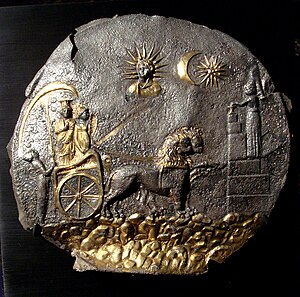
The Ai-Khanoum plaque is an ancient Greco-Bactrian disk discovered at the archaeological site of Ai-Khanoum in Takhar Province, Afghanistan. This Hellenistic city served as a military and economic center for the rulers of the Greco-Bactrian Kingdom until its destruction c. 145 BC. Rediscovered in 1961, the ruins of the city were excavated by the French Archaeological Delegation in Afghanistan (DAFA) until an outbreak of conflict in Afghanistan during the late 1970s. Among the structures excavated by the archaeologists was a sanctuary called the 'Temple of Indented Niches', (French: "temple à niches indentées"; alternatively "temple à redans", meaning 'Stepped Temple')[1] in which the disk was found. The disk is held in the collection of the National Museum of Afghanistan in Kabul.
This disk, depicting the Greek goddess Nike driving a chariot drawn by lions and accompanied by the Greek goddess Cybele, was described as "remarkable" by the Metropolitan Museum of Art on account of its "hybrid Greek and Oriental imagery".[2] Made of silver, the disk combines components of Greek culture, such as the chlamys all the deities wear, with Oriental design motifs such as the fixed pose of the figures and the crescent moon.[3] It has been described as "the most important work [of] the Greco-Oriental style".[4]
- ^ Mairs 2013, p. 92, note 29.
- ^ "Afghanistan: Hidden Treasures from the National Museum, Kabul". Metropolitan Museum of Art. Archived from the original on 27 June 2017. Retrieved 30 October 2022.
- ^ Bernard 1970, pp. 339–347.
- ^ Bernard 1996, p. 116.